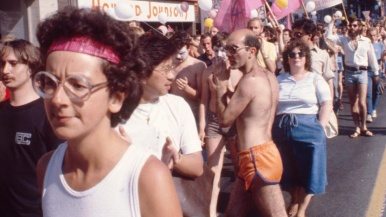The 10 biggest moments in Toronto politics in the last 50 years
To celebrate Toronto Life’s 50th year, we’re counting down the biggest Toronto moments of the last half-century. This month: the councillors, cops, mayors and protestors who mattered most. Disagree with our choice for number one? Have your say at the bottom

THE SUMMER OF STINK 2009
Five weeks that made a mess of the city and David Miller’s legacy
10 The 2009 city workers’ strike shut down daycares, ferries and swimming pools, but there was really only one thing on most people’s minds: garbage. With 1,100 trash collectors off the job for 36 days, 21 of the city’s arenas and parking lots turned into toxic cesspools of rotting food and netherworldly stench. In the standoff between the mayor and the union, Miller blinked first, and in the end, aside from a legion of full-bellied raccoons, no one was satisfied.

THE TORONTO ISLAND TURNING POINT 1980
The delayed eviction that became a victory for the islanders
9 The city had spent 24 years trying to turn Toronto Island into parkland. Then, suddenly, one morning in July, they ordered everyone out. The residents refused to leave—leading to a tense standoff between the protesters and law enforcement. The former won.

MEL LASTMAN’S REIGN OF REGRETTABLE QUOTES 1998-2003
The pre-meme meme machine
8 On enlisting the army to shovel 118 centimetres of snow that fell on Toronto in January 1999:
“Would I do it again? You’re darn right I would!”
Before a June 2001 trip to Kenya in support of Toronto’s 2008 Olympic bid:
“What the hell would I want to go to a place like Mombasa for? I just see myself in a pot of boiling water with all these natives dancing around me.”
To David Miller in 2002, a year before he was elected mayor:
“You will never be mayor of this city because you say stupid and dumb things!”

THE KILLING OF ALBERT JOHNSON 1979
A high-profile police shooting
7 Police shot and killed Johnson in his west-end home after receiving a call from a neighbour complaining that the Jamaican-Canadian father of four, who’d had frequent interactions with police, was being loud and disruptive. Forensic analysis determined he’d likely been shot while kneeling. A 2,000-person protest led to an investigation, but both officers were acquitted. The episode raised troubling questions about the use of force that remain unanswered still.

A TALE OF TWO YORKVILLES 1967
The battle to prevent the gentrification of the famous hippie hot spot
6 Yorkville was the bohemian hangout, site of Neil Young and Gordon Lightfoot jam sessions. In 1967, 58 hippies urged the city to pedestrianize Yorkville Avenue, but mayor Allan Lamport wanted a shopping centre instead. After a year of sit-, sleep- and love-in protests, the hippies, whose numbers had swelled to some 2,000, moved on, leaving the door open for retailers to create the shopping mecca we know today.

THE BATHHOUSE RAIDS 1981
An LGBT flashpoint
5 On the evening of February 5, 200 cops stormed into four bathhouses and arrested roughly 300 men. If their plan was to eradicate Toronto’s gay community, it backfired. The raids rallied the community and provoked multiple protests—including the Gay Freedom Rally, a precursor to today’s Pride events. Those protests sparked 34 years (and counting) of LGBT-affirming action that eventually changed both the Criminal and Ontario Human Rights codes.

HOGTOWN TO HUGETOWN 1998
Amalgamation brought T.O. together—and tore it apart
4 In theory, it sounded smart: mash together six municipalities to consolidate services and save cash. For a while, it worked—the city saved about $135 million annually for the first 10 years—and Toronto got a hefty new population figure to flaunt to the world. But the number of city staff actually increased after amalgamation, and the merger sowed resentment among suburbanites, a phenomenon that led in part to the ascension of one Rob Ford.

THE G20 2010
The fiasco, by the numbers
3 $1.1 billion Combined cost of G8 and G20 summits
$933 million Amount spent on security
$1.9 million Cost of the media centre and its $57,000 artificial lake
20,000 Number of police, military and security personnel
1,118 Number of people arrested
300 Approximate number of people “kettled” at Queen and Spadina
44 Number of people charged
1 Number of officers criminally convicted

THE SPADINA EXPRESSWAY VS. JANE JACOBS 1971
The Annex sage
2 When famed urbanist Jane Jacobs, Marshall McLuhan and their merry band of pedestrian-friendly followers convinced premier Bill Davis to cancel the Spadina Expressway in 1971 (leaving behind Allen Road), they influenced decades of urban planners with the guiding philosophy that cities are built for people, not cars.

THE GRAVY TRAIN WRECK 2010-14
Robert Bruce Ford, human disaster
1 Mention Toronto anywhere in the world today, and the instant response is “Oh yeah—crack mayor!” Yet Ford’s reign was so much more than a cocaine binge, and so much more than lawsuits, lewd spousal commentary, furtive KFC runs, phone calls while driving, sneaking out of council to coach football and the demonization of all public servants not named Ford. No, besides providing A-plus material for Jimmy Kimmel and Jon Stewart, Ford exposed our urban-suburban fault lines, disproved the theory of Toronto the harmonious and paved the way for a uniter—John Tory’s “One Toronto” platform was no coincidence—to succeed him. Ultimately, Ford’s politics of divisiveness brought a city together. The Ford experience was feverish, mortifying and even sometimes fun, and no one will forget it.














Interesting list. I would say that ‘carding’ deserves a place on here as well. It’s been as contentious and important an issue as many of the issues listed here, maybe more so.
Hands down Rob Ford will go down as the biggest mistake ever!
What an interesting time we have had in Toronto.